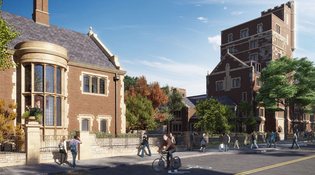 loading
loading
Light & VerityConstruction to start on new collegesA recession-delayed project to expand enrollment by 15 percent.  Robert A. M. Stern Architects, LLPAn architectural rendering depicts two new residential colleges as seen from Prospect Street. The colleges have been designed by Robert A. M. Stern Architects in a Gothic style similar to Yale buildings of the early twentieth century. View full imageSix years after Yale’s trustees voted to expand the enrollment of Yale College and build two new residential colleges, the long-delayed project is now moving forward. President Peter Salovey ’86PhD announced on June 2 that the university had raised the $500 million needed for the project and is soliciting construction bids. “If we receive satisfactory proposals, we can begin construction this winter,” Salovey wrote in his biweekly e-mail newsletter. The opening is anticipated in the fall of 2017. The colleges, which will be built on Prospect Street between the Grove Street Cemetery and Ingalls Rink, will accommodate 904 students. Besides allowing a 15 percent increase in enrollment, from 5,400 to 6,200, the colleges will help deal with overpopulation in the existing 12 colleges and reduce the need to house students in annex space. Former President Richard Levin ’74PhD first publicly broached the idea of expanding the colleges eight years ago. “The competition for slots has become so intense that we feel that if we could give more people access to a Yale education we can make a stronger contribution to America and the world,” Levin told the Yale Alumni Magazine in late 2006. The Yale Corporation approved the expansion plan in June 2008, and the goal of the university’s then-active capital campaign was raised from $3 billion to $3.5 billion to fund the colleges. They were to be completed by the fall of 2013. But just three months later, in September 2008, the global financial crisis came to a head, and Yale’s endowment lost 29 percent of its value. The capital campaign exceeded its goal, reaching $3.8 billion by the time it ended in 2011, but the money went to shore up existing programs instead of expansion. Fund-raising for the colleges got a gigantic jump start last year, when Charles Johnson ’54 gave $250 million—the largest single gift in Yale’s history—toward the project. That left $80 million to go, a gap that was closed through gifts at reunions this year. Although the plan has moved forward with little public dissent, some faculty have expressed concern about the wisdom of expanding when the university is still cutting its budget in the face of deficits. “We haven’t been assured that the resources for maintaining the quality of a Yale education with the addition of the new colleges will be made available,” writes English professor Jill Campbell in an e-mail. A faculty committee appointed to review the impact of the new colleges observed in its May report that the Faculty of Arts and Sciences had increased from 651 to 700 since 2008, enough to accommodate the new colleges. But Campbell says she and others are skeptical that the increase in faculty was targeted for teaching needs. The committee recommended “a small, targeted increase in funding for non-ladder instruction”—that is, non-tenure-track teachers for English, foreign language, and science classes—and allowing “some flexibility” in class-size limits. And since there will be increased demand for sections in lecture courses but no corresponding increase in teaching assistants at the Graduate School, the report suggests developing “non-traditional approaches to section instruction—e.g., professional students as teaching fellows, undergraduate peer tutors, and preceptors to oversee and teach gateway courses.” The Corporation has not yet said what the colleges will be named, but it has decided that they will be named not for donors but for notable people with ties to Yale. For now, they’re being referred to as North and South Colleges.
The comment period has expired.
|
|